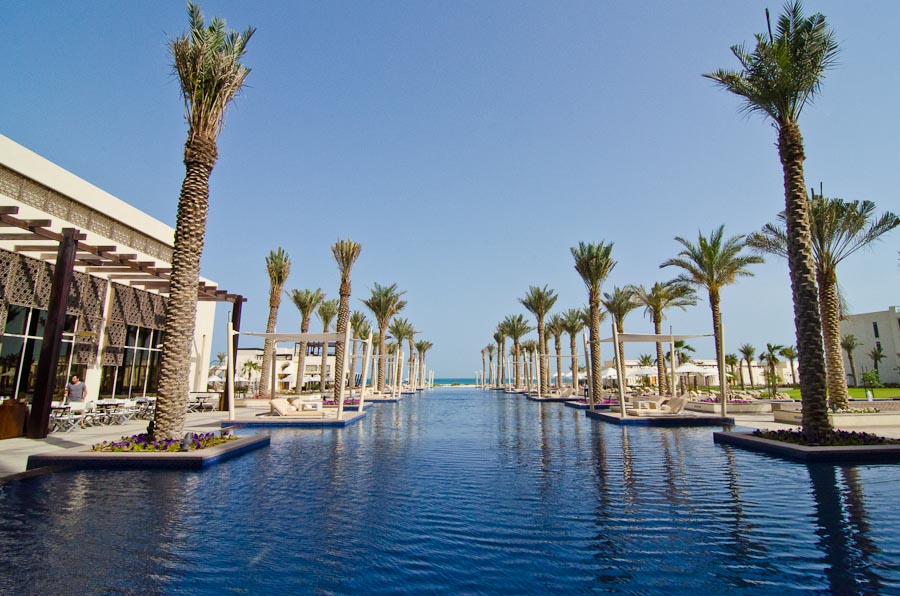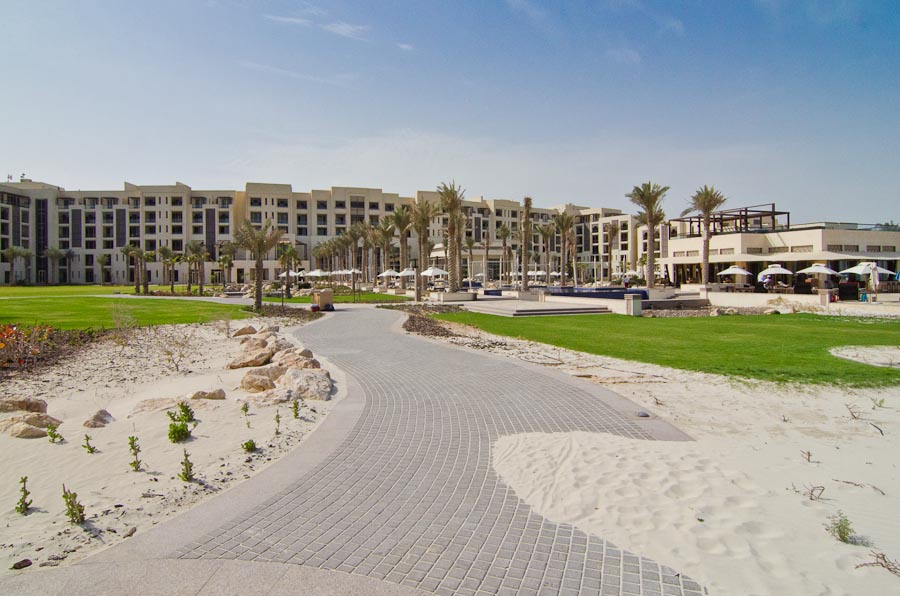This morning we woke up in our nice, new and very modern suite at the Park Hyatt Saadiyat Beach Hotel in Abu Dhabi. We really are a long, long way from home but you’d swear we were at a new hotel in Newport Beach!
Today we’ll be taking the bus back to Dubai where we’ll visit the Dubai Mall and take the fastest elevator ride to the top of the tallest building in the world!
Click here for the detailed Dubai Photo Gallery.
I want to apologize in advance for all of the pictures of buildings…but I’m a sucker for beautiful buildings and there are a TON of them here in Dubai.
After a very nice buffet breakfast in hotel restaurant on the ground floor, we had some time to take a walk on the beach and check out the property. At 10:00 am we boarded the bus for the 90-minute drive back to Dubai.
The bus dropped us off at a parking lot across from the Dubai Mall complex where the world’s largest shopping mall and the world’s tallest building are located.
The Dubai Mall has over 1,200 stores. This is amazing considering it’s just a few miles from the Marina Dubai Mall, which is also one of the largest in the world and includes its very own ski slope. We didn’t have time to get over to see and document that but some of the people on our bus had seen it previously. They told us that it is freezing cold inside and they dress you up in parkas and other skiwear if you want to take a run down the slope. Amazing to be in the middle of the desert and go skiing!
The mall looked much like any other high-end mall in the US. Same type of food in the food court too, including Mrs. Field’s Cookies and Fatburger. We only had 30 minutes to shop but Margaret and I managed to find a Manolo Blahnik store but she was disappointed to find that their Spring collection wasn’t the same as she had found at Neiman Marcus in the US. Oh well!
The Burj Khalifa, the worlds tallest building, was constructed beginning in 2004 and was opened in 2010. It was designed by a Chicago firm and built by a South Korean company. The building cost $1.5 billion and the entire development in the area cost $20 billion. That’s a lot of dough.
The office space was going for $4,000/sq ft and the residences were selling for $3,500/sq ft upon completion. But, with the economic collapse, the prices plummeted 40% and the project had to be bailed out by Abu Dhabi, hence the name was changed to honor the UAE President. At that time 90% of the apartments were still vacant. Eventually, 25,000 people will live in the entire complex.
This building is the tallest in the world at 2,733 feet. The last time that the tallest building was in the Middle East was the Great Pyramid which lost it’s standing in 1311. The elevators are the fastest in the world at 40 mph and the observation deck we went to on the 124th floor was almost 1,500 feet tall, over a quarter mile up. The building is designed to sway about 5 feet from side to side at the top.
The halls leading to the building are pretty extensive and include a couple nice escalators. They show multimedia presentations constantly and there are educational displays and nicely lighted exhibit signs along the way. Pretty cool. The elevators had a light and music show, more exciting going up, more relaxing going down. The ride was very smooth and fast. I had to pop my ears at least twice.
The observation area was nice, not too crowded but the view was very hazy. I was impressed with how Photoshop Lightroom was able to make the pictures look pretty darn good! A little surreal, but good.
We walked back to the bus and drove to the port after waiting about 30 minutes for a couple stragglers to finish buying things in the souvenir store. On the way out Margaret told me that a place had iPad 3’s in stock! But, it was now too late to get one. Darn!
Photography Comments:
Since we were in the bus most of the trip I figured I’d at least take pictures of the amazing buildings in Dubai. Using the D7000 and the 28-300 lens for most of them. On the D7000, a DX (half frame) camera, the 28 end becomes 1.5X that or 42mm, almost a standard 50mm lens. So, it can be a challenge to get the entire building in but I did a decent job, especially considering that there is a monorail track in the way much of the time. In the Burj Khalifa I used my 11-16 wide angle lens the entire time. This worked out pretty well. Pretty amazing really. And, Photoshop Lightroom did a great job eliminating all the haze from the building and high altitude shots of the surrounding area. I’m practicing switching from still to video with the D7000. One of the challenges is the lens focusing motors make annoying noises so you pretty much have to go to manual focus mode. Then, when you take stills you have to remember to manually focus which is a skill that is fading now that the auto focus genius built into the cameras is so darn good. Eventually, I’ll train myself to remember this but who knows. In the meantime, a couple great shots I had were slightly out of focus…part of the game.



.jpg)


